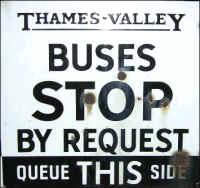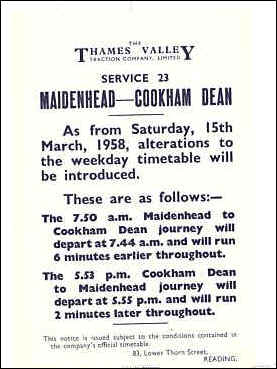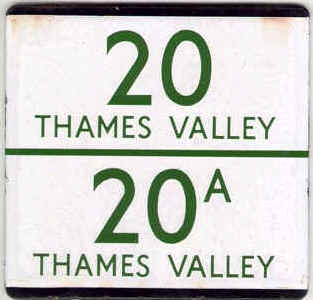A Cookham History
The Thames Valley Traction Company
with thanks to Alan Gryfe - www.eplates.info/othersTZ.html
 The Thames Valley Traction
Company was founded in 1897. Although the Thames Valley Traction Company
Limited was formed in 1920. The company was merged with Aldershot & District in 1972 to form Alder
Valley, the companies separating in 1986 with the former Thames Valley
company becoming the Berks Bucks Bus Company, trading as Beeline. This
company was acquired by Centrewest in 1996 and became part of the First
Group in 1997.
The Thames Valley Traction
Company was founded in 1897. Although the Thames Valley Traction Company
Limited was formed in 1920. The company was merged with Aldershot & District in 1972 to form Alder
Valley, the companies separating in 1986 with the former Thames Valley
company becoming the Berks Bucks Bus Company, trading as Beeline. This
company was acquired by Centrewest in 1996 and became part of the First
Group in 1997.
Thames Valley route 20 provided a regular daily service between High Wycombe (Bus Station) and Windsor Central Station via Wycombe Marsh, Loudwater, Wooburn Green, Bourne End, Cookham, Boulters Lock, Maidenhead and Fifield. One bus per hour was numbered 20A and served Hatch Bridge instead of Fifield. This “E” plate could have come from a busy stop in any of the places where London Transport ran: High Wycombe, Slough or Windsor, although most likely from Slough.
A Thames Valley Traction Company Leaflet
With thanks to Michael Waring
I worked for the company for four years after leaving school in 1959 and at that time lived in Bracknell.
During the early 1960's the service was linked with the High Wycombe - Aylesbury service (no. 30) thereby forming a through service from Windsor to Aylesbury.
This was however split again in the late 1960's largely, I think, due to unreliability caused by severe traffic congestion when travelling through High Wycombe which at that time had no M40 to relieve ever growing traffic levels.
I know this to my cost as the only time I used the service from end to end I ultimately missed a coonection in Aylesbury with the bus to Northampton (by 15 minutes) and which only ran four times a day! Still, my pal and I managed to reach Nottingham by teatime with a slight rearrangement of our plans.
Referring to the bus stop plates the green on white service number plates were standard London Transport ones used to indicate that the stops were also used by non LT buses.
I would suggest that those shown would have been sited along the section of the A40 leading into High Wycombe where LT would have taken responsibility for the bus stops due to it being within the LT operating area.
The suggestion that it might have been sited in the Slough area is of course a bit wide of the mark as service 20 never served Slough!
Thames
Valley was formed as such in 1920. Its origins go back a few years
earlier when the British Automobile Traction Company started
running buses in the Reading area in 1915. That company, known as BAT,
was a subsidiary of the British Electric Traction Company, known as
BET, whose primary interest was the promotion and ownership of
tramways throughout the UK. BET saw that, to limit competition, their
way forward was to promote and invest in bus operations through their
subsidiary, BAT, and hence that was the reason they started a branch
in Reading. Expansion was such by 1920 that a new BAT subsidiary was
formed called Thames Valley.
This
was typical of how BAT started operating buses in many towns until
growth warranted the formation of a separate company in its own right.
Meanwhile
another expanding bus operator in London, Thomas Tilling, began buying
in to bus companies across the country and Thames Valley was just such
a company. The history thereafter gets a bit more complicated but
suffice it to say that during mid World War 2 control of Thames Valley
switched from BET to Thomas Tilling. Thomas Tilling was actually
formed as a company in 1897 although their interest in Thames Valley
did not come until the late 1920's. The true origins of Thames Valley
therefore date from 1915.

